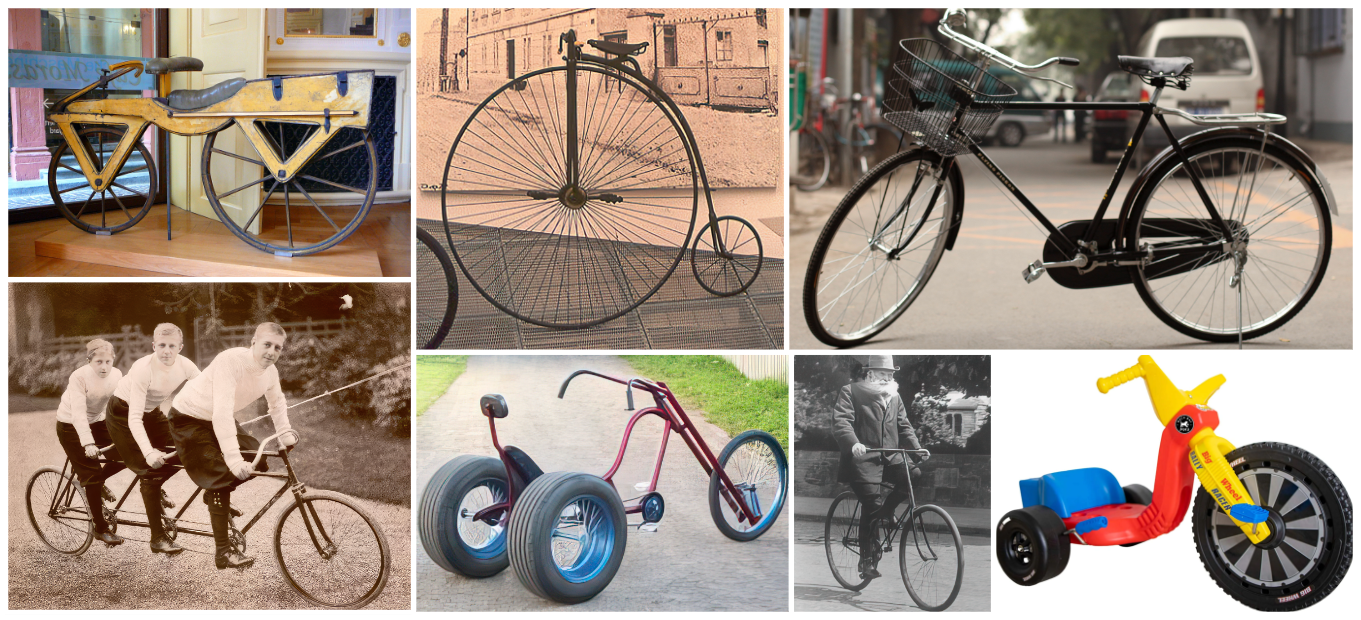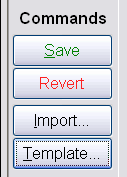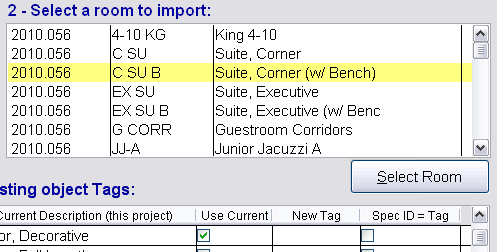Building FF&E Projects with Templates
FF&EZ’s Import and Clone commands can let you create an extraordinarily powerful, multi-level system of templates for use in your projects—even projects that are highly creative and unique designs. By making it easy to start interior design projects using your pre-built components—from mere "skeleton" specs to fully populated rooms and project sections—the software can save an enormous amount of time while ensuring that your project includes all needed design components. Here we will take a look at how those functions can do this.
The Interior Design profession and its technical sibling FF&E Specifying can encompass a range of situations, from 1) very repetitive work to 2) work that repeats functional requirements without repeating the actual products, to 3) completely custom, high-end work that involves shop drawings and special fabrications. Designers justifiably take pride in producing unique designs, but that does not prevent you from finding hidden but natural repetition in your work; this is the key to discovering how templates can help everyone. In fact, unless you are designing the very first restaurant on Mars — for Martian clients — you are going to find that there is repetition in how you define most of the components you need, if not always the style.
Wait...How Big of a Wheel Did You Say?

For instance, if I ask you to describe something as basic as a wheel, one look at these photos will instantly prove that it would take quite a large book to describe all the possibilities. But every functional wheel worth spending money to buy has a set of common properties:
- It must be a circle with a particular radius
- It has a width that relates to its function
- It has an edge shape that relates to its function
- It must have a mechanism that allows it to turn consistently
- It must have a way to demount it for repair or replacement
- It must be made of a material appropriate to its function
- It must meet standards of strength and wear that make it practical for its purpose
So, if we design a system to both store information about wheels and also prompt our less than perfect memories about some minimum properties we need to describe them, it might start with these:
- Type
- Radius
- Width
- Edge configuration
- Type of movement
- Connection type
- Material
- Wear test
If we put these into a reproducible format with space to add the actual information later, we have a template.
However, the types of wheels in thes photos include gears, so we know that we need more than just these properties. Yet, we cannot really predict how many different properties might be needed to describe all the possible wheels in the world and a single format containing all the possible properties would be unwieldy to manage.
Specification Templates: The basic building block
We have the same problem in describing the products (specifications) that go into the objects that we intend to place in a room: There are many floor and wall finishes, types of seating, configurations of drapery, etc. These all share a certain number of very common properties like "Size," "Color" and "Material" that we can include in every basic template, but we also need a flexible way to handle the incredible number of variations that can occur. So if there was a way to start with a very basic template of the most common properties and then copy it and add those that were specific to that product type (including boilerplate for standards and required tests), you could develop a set of templates for the specifications you plan to use in a project without knowing specifically what products were being used.
The single most flexible way to do this is with a multi-purpose, variable length field, such as FF&EZ's "Additional Description" field and a way to pre-fill it with the specific properties you need for each type of product.
Once you have created those spec templates, you can import them into a project anytime you need them. For example you can use the Template command in FF&EZ, which is available any time you are adding or editing a specification. FF&EZ can also automatically use a template when it creat
Hint: If you are already using FF&EZ and have existing project specs that might make the basis of a template, you can use the Library's Add> Import command to import the specs from the project. Then, by removing all vendor- and project-specific details, you can save the remaining information as a template.
Object Templates: Shortcuts to building complex items
The next step up from specifications would be FF&EZ's "objects" (or in other software, "assemblies" or “blocks”) made up of one or more products specified by the designer. These are much easier to create, since they are basically just a list of specifications forming the components of the object template. Since object templates point to a set of specifications, you can maintain and improve your object templates by simply maintaining the content of your base specifications, which are in turn built on templates. In FF&EZ, object templates are kept in special projects set up for this purpose and then imported with the normal Import option of the Object screen's Add command, although you can of course, import an object from any project.
In all cases, you may also want to add a budget number to the object template, especially if a group of objects is meant to represent a certain segment of an industry. This further leverages this information in helping you build and test budgets before product selection starts.
Room Templates: Trading a big wheel for a really big lever
Let’s set aside the subject of single objects and specifications for a moment and look at other ways that we find repetition in interior design, starting with the next step up: Rooms. Although we might do a unique design for each client, it remains true that if you are designing a kitchen, it will have at least one stove, a refrigerator, and a sink in it. The stove will need a vent of some kind and cabinetry and counter space.A startup kitchen will also have a fairly standard set of other accessories in it, along with lighting and floor treatments. If it's a commercial kitchen, there will be separate workstations for food prep, plus cold storage. A similar repetitive pattern occurs in the dining area, office, etc.. This becomes especially obvious in all commercial building areas that have a specific functional purpose.
This leads to something powerful: If we can take our object templates and build a room “type” with the typical objects that you would find in that type, you can create a room template. Further, you can “overload” the room template with some common variations that you may or may not use in every project. For instance, a hotel room might have a media system stand or a media system armoire—you simply delete the one you don’t want in the live project. Or: you can copy a basic room template and add or subtract object templates and/or new objects to create a room variation (such as a king-size hotel room vs. a queen size vs. an “accessible” room).

All of these room templates can be saved into a project from which you can later import them when working on a new project. Think about what you can accomplish in the early stages of a project if you could simply import a set of rooms as a starting point for your FF&E content, all of which come into your project pre-populated with specifications built with templates. FF&EZ makes this possible with the Import option of the Room screen's Add command and all the functions discussed up to this point.
Templates that are more than templates
So far, we have been talking about a template as an “empty” structure of property labels to be filled out and perhaps boilerplate, designed to hold the actual descriptions of products that will be added later in a live project, after products have been selected based on an actual plan.
However, if you work in a more structured design environment guided by franchise or corporate standards, the use of templates becomes even more powerful without necessarily sacrificing flexibility and originality where it is needed:
- The specifications for any object template can be detailed with actual products and saved just like an “empty” template is saved.
- Standard rooms can be built just as easily from detailed object templates as from the original ones.
- A project that is a mix of standard rooms and spaces with original designs (a typical situation in a mid-scale hotel) can be built by simply using the appropriate room templates: fully detailed standard rooms and a mixture of non-detailed room “types” and rooms built completely from scratch with new objects and specifications.
Yet, even in a fully custom project, you still have the ability to import a specification template you've created for each product type. There is a huge payoff in learning to mix and match after setting up your templates.
Note that FF&EZ's Library only contains specifications, whether fully detailed or prototype templates. However, you can easily create "library" projects that contain prototypes and templates for both objects and rooms and import from these "library projects" just as easily as you import from the Library itself.
Project Templates: It can't get easier than this
The final kind of template that you can create is that of an entire project, consisting of room templates built out of object and spec templates. As I've implied in the text above, this can consist of any combination of content, including:
- “Skeletal” templates preloaded with the basic lists of product properties and boilerplate as needed
- A complete franchise prototype, fully detailed
- Just the “standard” sections of a building (like hotel room types), leaving the custom portions (e.g., a lobby) to be added
- Any other combination of content that makes sense for your work
What does it take?
All that the above requires, starting with the simplest specification template, is:
- A little pre-planning and perhaps, listening to a small voice muttering "There must be an easier way!"
- Time spent setting up your templates, which you can do 1) as part of an initial setup, 2) on the fly as you realize the need for a new one or 3) by importing well-tested existing specs into the library and stripping them down to a "generic" version.
- An FF&E specifications database that allows you to clone (copy) and/or import specifications, objects created from them, rooms with all their contents and entire projects.
You can read about FF&EZ's ability to easily clone and import project components at this post — or email/call us to have a demonstration of these capabilities. This flexibility is possible because FF&EZ is not designed as just a specification writing program but as an FF&E data management tool.
